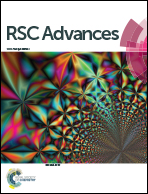Highly fouling-resistant brominated poly(phenylene oxide) membranes using surface grafted diethylenetriamine†
Abstract
Hydrophilic bromomethylated poly(phenylene oxide) (BPPO) ultrafiltration membranes were prepared via a single-step reaction with diethylenetriamine (DETA). The resulting DETA modified BPPO membranes are characterised using FTIR-ATR, SEM, fouling resistance, filtration test and contact angle measurements. Although permeation flux was adversely affected, the chemically bound DETA leads to a significant increase in surface hydrophilicity and anti-fouling properties of BPPO/DETA membranes. The composite BPPO/DETA membranes show a considerable reduction in membrane fouling and enhanced BSA rejection, with foulants easily removed by normal cleaning methods. Herein, a facile surface modification with DETA is shown to be an effective means of enhancing the flux recovery ratio and anti-fouling properties of BPPO membranes.



 Please wait while we load your content...
Please wait while we load your content...